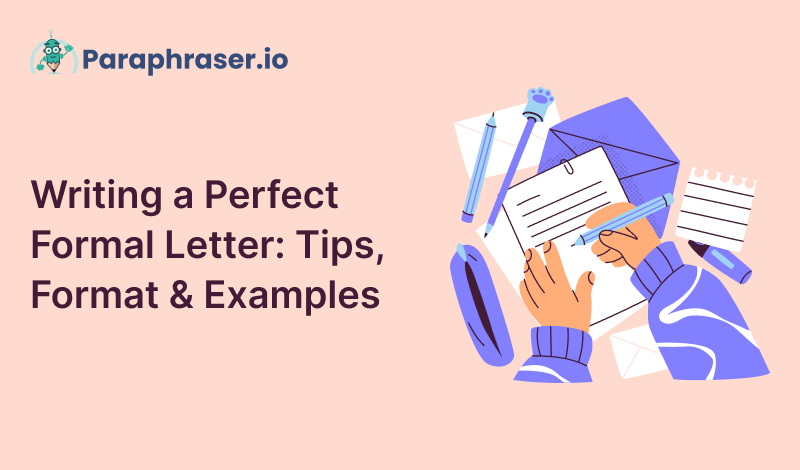
Writing a Perfect Formal Letter: Tips, Format & Examples
Writing a perfect formal letter is essential for clear communication in various fields. A professional letter makes the right connections to initiate meaningful conversations.
A well-structured formal letter represents your professionalism and attention to detail. It allows you to define the tone for your message. It also ensures that you leave a positive impression on the recipient.
In this blog, we will discuss how to write an effective formal letter & its essential elements. With this guide, you will feel confident in composing formal letters in any situation. You will learn to start from an engaging opening to a perfect conclusion & how various elements are used to create one.
Why do We Need an Official Letter?
Official letters are used to provide information, express an opinion, or other purposes. It is the only way to communicate in a professional setting. One of the most common examples is writing a letter to apply for a job. In such cases, a cover letter is sent along with the resume. It presents your qualifications and explains your interest in the position.
Formal letters are also used for business communication, especially for professional inquiries, requests, or addressing concerns. Other scenarios include writing to government bodies, responding to legal notices, or submitting complaints. Different types of professional letters include acceptance letters, apology letters, resignation letters, sales letters, and more.
Parts of a Formal Letter
Apart from the format, it is essential to include all the necessary components of a formal letter correctly. It ensures that your formal letter is both professional and effective. Here we have broken down each element.
Sender's Information:
This part includes your full name, address, and contact details. This detail will provide the recipient with a way to reach you.
Date:
The full date is added to avoid confusion and keep a track, especially in international correspondence.
Recipient's Information:
It contains the receiver’s name, job title/ company, and address.
Salutation:
A respectful greeting is added before the main body addresses the recipient.
Subject Line:
This part contains a short and clear line to let the recipient know the purpose of the letter right away.
Body:
The body of the letter is divided into three main parts.
-
A clear and direct introduction.
-
Main content that provides the details, makes a request, or explains the position.
-
The conclusion states what action you would like the recipient to take.
Closing:
The letter ends with a polite closing phrase, such as "Sincerely" or "Yours faithfully.”
Signature:
The printed name and signature are added after the closing phrase.
Steps to Write a Formal Letter
Unlike informal letters or emails, formal letters have a structured format. This structure helps convey a sense of seriousness and professionalism. It requires a clear structure and a thoughtful approach. Here are the important steps to help you craft a professional letter.
Know the Purpose
Planning is an important part of writing as it helps you to have a clear idea about the text. It will help you to know the exact reason of writing and the target audience. Moreover, defining the purpose ensures that your message stays focused and to the point.
Use a Letter Format
The next step is to use the standard format for a professional letter. This provides the letter with a proficient and professional look. Use a professional format for the text and align it to the left. The whole text must be single-spaced with one blank line after each paragraph. Also, leave a two-inch margin at the top and bottom of the document.
Start with a Clear Opening
Start writing your letter by introducing yourself. This introduction must be short and concise. Also, state the purpose right away. This allows the reader to understand your intent immediately without reading through paragraphs.
Write Body Paragraphs
The body paragraphs will contain all the points crafted in a logical and transitional way. Each paragraph should cover a single topic or idea to make it easier for the reader. Use straightforward language and follow the outline.
After writing the body of the letter, you can paraphrase it to maintain a consistent tone in the content. This could be done using an online paraphraser.
How to do it perfectly, check out our guide on how to paraphrase a paragraph. It will help you to create a transitional flow between sentences and paragraphs. It will help you to create a transitional flow between sentences and paragraphs.
Write in a Formal Tone
Keep the tone professional but polite. Avoid informal expressions and stick to a consistent style throughout the letter. A formal tone shows that you are taking the matter seriously and professionally.
Close Effectively
In the last paragraph, summarize your message and state what you hope to achieve. You can directly write about the action you are expecting from the recipient. End your letter with a professional phrase.
Proofread
After finalizing the letter, always review it to identify errors. Check grammar, spelling, and punctuation mistakes as they can ruin the outlook of the letter. You can run the text through the grammar checker to instantly identify and rectify these mistakes. It is valuable for writers as it helps to write an error-free letter.
Tips for Writing a Professional Letter
With the right approach and strategies, you can craft impactful formal letters. Here are some expert tips to keep in mind.
Use a Professional Tone
Always maintain a formal and respectful tone throughout your letter. Avoid casual language, slang words, or overly emotional expressions.
Be Clear and Concise
The best formal letters get straight to the point. Avoid unnecessary details or lengthy explanations.
Keep the Structure Consistent
Ensure that your letter follows a consistent structure. A well-organized letter is easier to read and represents your professionalism.
Add a Call to Action
A call to action must be added just before closing the letter. Tell the recipient that you want them to perform a specific action calmly and professionally.
Ensure Originality
It is easy to just copy a letter from the Internet and tweak it for your purpose. But this practice will lead to plagiarism. Therefore, write the letter by yourself and always check plagiarism before sending it. Recommendations or cover letters may contain plagiarism, but you can identify it using the plagiarism checker. If your text includes any duplication, you can rewrite it to maintain originality.
Formal Letter Template
Here is a formal letter template example for professional writing, which you can use to write emails or letters.
-
[Your Name]
-
[Your Address]
-
[City, State, ZIP Code]
-
[Phone Number]
-
[Email Address]
-
Date: [Month Day, Year]
-
[Recipient's Name]
-
[Recipient’s Job Title]
-
[Company Name]
-
[Company Address]
-
[City, State, ZIP Code]
-
Dear [Mr./Ms./Dr.] [Recipient's Last Name],
-
Subject: [Optional, but can be used to mention the purpose of the letter briefly]
-
Introduction
-
[Briefly introduce yourself and state the purpose of the letter.]
-
Main Body Paragraphs
-
Conclusion
-
Sincerely
-
[Your Name]
-
[Your Title]
Examples of Formal Letters
Job Application Letter
John Doe
1234 Main Street
December 7, 2024
Ms. Jane Channing
Hiring Manager
XYZ Corporation
5678 My Street New York
Dear Ms. Channing,
Application for Marketing Manager Position
I hope this message finds you well. I come to know that your company has vacancy for Marketing Manager. I would like to apply for that role. With five years of experience in marketing, I have developed a strong skill set that aligns with your requirements.
In my previous positions, I have successfully managed various marketing campaigns and developed strategic marketing plans. I am particularly skilled in analysing market trends and making effective decisions.
I am excited about the opportunity to contribute to your team. I have attached my resume.
I look forward to hearing from you soon.
Sincerely,
John Doe
Complaint Letter
James Martin
246 Pine Street, Springfield
27th November, 2023
Mr. Mathew Garfield
Customer Service Manager
XYZ Energy
Dear Mr. Garfield,
I want to address an issue regarding my most recent electric bill. I was charged an amount that does not match my actual usage. It resulted in an overcharge for the month of November.
I have attached the copy of my bill and payment history for reference. I would like you to investigate and provide a corrected statement. I am available for further clarification or to provide additional information.
Thank you for your attention to this matter.
Sincerely,
James Martin

